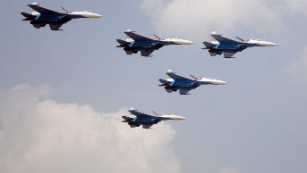War in Syria: Six graphics that explain the latest on the ground
As if the airspace over the war-torn country wasn't already crowded enough, fighter jets announced Russia's arrival on the ever-growing list of nations who have bombed Syria when it launched airstrikes on rebel targets on Wednesday.
A coalition of countries led by the U.S. have been bombing ISIS targets on a near-daily basis since last September, in the hopes of rooting out the terror group from its strongholds in Syria.
But Russia's arrival on the scene marks a new and uncertain chapter in a war that has now killed more than 250,000 people since 2011.
Here's everything you need to know about Russia's military intervention in six graphics.
Russia has set up shop in western Syria
For weeks Russian President Vladimir Putin has been preparing for airstrikes by flying equipment and personnel to locations around Syria -- particularly on the Mediterranean coast -- including the airport in Latakia, Russia's naval base at Tartus, and the capital Damascus.
Russia now has seven positions set up in Syria, according to the Institute for the Study of War, a Washington-based think tank.
Russia says it's bombing ISIS but the U.S. isn't buying it
The Russians says they will take the fight to ISIS and "other extremist groups" in Syria -- but on Wednesday the targets they hit appeared to be hours away from the nearest ISIS strongholds.
U.S. Defense Secretary Ash Carter said Russia didn't appear to hit targets under the control of ISIS. And Syrians on the ground told one expert that the bombs targeted other rebel positions, including the headquarters of the moderate, Western-backed Free Syrian Army.
Experts are skeptical of Russia's motives
Putin says he's intervening in Syria to attack ISIS and other extremist groups, but some experts say he has ulterior motives.
One of them is to preserve the rule of Syrian President Bashar al-Assad, a key ally in the region.
Another is to fortify Russia's naval base at Tartus, which provides access to the Mediterranean. Russia is landlocked except for in the north, so Tartus is one of just two warm water bases -- meaning it never freezes over -- it controls anywhere in the world. (The other is at Sevastapol in Crimea, which Russia annexed last year from Ukraine.)
Putin's deployment of fighter jets around Syria could allow Russia to extend its military influence across the region -- from Turkey (which Russian jets could reach within minutes) and Iraq to Jordan and Israel.
The big guns have raised some eyebrows
Satellite photos taken over the past few weeks show top-of-the range Sukhoi Fencer fighter jets and T-90 tanks, transport and attack helicopters, and armored vehicles appearing at Syrian bases. According to IHS Jane's Intelligence Review, the photos show nearly 30 combat aircraft.
The influx of advanced aircraft has raised eyebrows and prompted some observers to question exactly who Russia's planning to fight in Syria.
"Many of [the weapons] don't seem to be well-suited to fighting ISIS. They're built to battle adversaries like the United States," the Daily Beast reported Wednesday.
Secretary of State John Kerry was similarly alarmed two weeks ago. He told CNN: "Clearly, the presence of aircraft with air-to-air combat capacity as well as ... surface-to-air missiles raises serious questions."
The Americans are downplaying Russia's intervention ...
... but their own attempts to stop ISIS have been disappointing. On Monday the U.S. announced that 28,000 foreigners from 100 countries are now fighting with ISIS in Syria and Iraq. That's nearly double the figure from 2014.
More than 250 Americans are now fighting with ISIS -- more than half of whom left the U.S. in the past year.
Meanwhile, the government's plan to train moderate rebels has been a flop. The goal was to train 3,000 to 5,000 fighters a year. So far the U.S. has trained an estimated 75 rebels -- some of whom were kidnapped as soon as they crossed into Syria.
Progress in the war on ISIS is being made -- at least in terms of land
Despite the year-old U.S.-backed aerial campaign, ISIS hasn't been beaten back from its key strongholds of Raqqa in Syria, or Mosul in Iraq -- and since then the group's also seized Palymra and Ramadi.
But it appears progress is being made. According to IHS Jane's Intelligence Group, the territory controlled by the terror group has shrunk by 9.4% in the first six months of 2015.
News Courtesy: www.cnn.com











